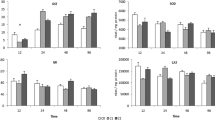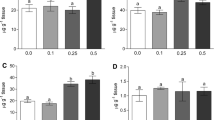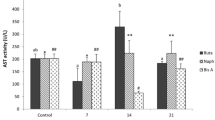Abstract
Flatfish species, such as the turbot (Scophthalmus maximus), are common targets for toxic effects, since they are exposed through the food chain (ingestion of contaminated preys) and are in direct contact with the waterborne contaminant and sediments. Furthermore, these fish species live in close proximity to interstitial water that frequently dissolves high amounts of contaminants, including metals. Despite this significant set of characteristics, the present knowledge concerning flatfish contamination and toxicity by metals is still scarce. To attain the objective of assessing the effects of metals on a flatfish species, S. maximus specimens were chronically exposed to lead, copper and zinc, at ecologically relevant concentrations, and biochemical (oxidative stress: catalase and glutathione S-transferases activities, and lipid peroxidation; neurotoxicity: cholinesterase activity) parameters were assessed on selected tissues (gills and liver). Copper had no significant effects on all tested parameters; lead was causative of significant increases in liver GSTs activities and also in lipoperoxidation of gill tissue; exposure to zinc caused a significant increase in catalase activity of gill tissue. None of the tested metals elicited noteworthy effects in terms of neurotoxicity. The obtained results showed that only the metal lead is of some environmental importance, since it was able to cause deleterious modifications of oxidative nature at relevant concentrations.



Similar content being viewed by others
References
Ademuyiwa O, Ugbaja RN, Rotimi SO, Abam E, Okediran BS, Dosumu OA, Onunkwor BO (2007) Erythrocyte acetylcholinesterase activity as a surrogate indicator of lead-induced neurotoxicity in occupational lead exposure in Abeokuta, Nigeria. Environ Toxicol Pharmacol 24:183–188
Aebi H (1984) Catalase in vitro. Methods Enzymol 6:105–121
Aktar MW, Sengupta D, Chowdhury A (2011) Occurrence of heavy metals in fish: a study for impact assessment in industry prone aquatic environment around Kolkata in India. Environ Monit Assess 181(1–4):51–61
Antonio MT, Corredor L, Leret ML (2003) Study of the activity of several brain enzymes like markers of the neurotoxicity induced by perinatal exposure to lead and/or cadmium. Toxicol Lett 143(3):331–340
Ashry KM, El-Sayed YS, Khamiss RM, El-Ashmawy IM (2010) Oxidative stress and immunotoxic effects of lead and their amelioration with myrrh (Commiphora molmol) emulsion. Food Chem Toxicol 48(1):236–241
Ballatori N (1994) Glutathione mercaptides as transport forms of metals. Advanced Pharmacol 27:271–298
Bradford M (1976) A rapid and sensitive method for the quantification of microgram quantities of protein utilizing the principle of protein dye binding. Anal Biochem 72:248–254
Brown RJ, Galloway TS, Lowe D, Browne MA, Dissanayake A, Jones MB, Depledge MH (2004) Differential sensitivity of three marine invertebrates to copper assessed using multiple biomarkers. Aquat Toxicol 66(3):267–78
Buege JA, Aust SD (1978) Microsomal lipid peroxidation. Methods Enzymol 52:302–310
Calabrese EJ (2008) Hormesis: why it is important to toxicology and toxicologists. Environ Toxicol Chem 27:1451–1474
Caplat C, Oral R, Mahaut M-L, Mao A, Barillier D, Guida M, Della Rocca C, Pagano G (2010) Comparative toxicities of aluminium and zinc from sacrificial anodes or from sulphate salt in sea urchin embryos and sperm. Ecotoxicol Environ Saf 73:1138–1143
Connan O, Tack K (2010) Metals in marine environment (mollusc Patella sp., fish Labrus bergylta, crustacean Cancer pagurus, beach sand) in a nuclear area, the North Cotentin (France). Environ Monit Assess 165(1–4):67–86
Cunha I, Mangas-Ramirez E, Guilhermino L (2007) Effects of copper and cadmium on cholinesterase and glutathione S-transferase activities of two marine gastropods (Monodonta lineata and Nucella lapillus). Comp Biochem Physiol Part C Toxicol Pharmacol 145(4):648–657
Dai W, Fu L, Du H, Liu H, Xu Z (2010) Effects of montmorillonite on Pb accumulation, oxidative stress, and DNA damage in tilapia (Oreochromis niloticus) exposed to dietary Pb. Biol Trace Elem Res 136(1):71–8
Dutta S, Kole RK, Ghosh S, Nath D, Vass KK (2005) Impact assessment of lead on water quality of river Ganga in West Bengal. India Bull Environ Contam Toxicol 75:1012–1019
Edens FW (1985) Whole brain acetylcholinesterase activity in lead-exposed Japanese quail. Poult Sci 64(7):1391–3
El Khalil H, El Hamiani O, Bitton G, Ouazzani N, Ali B (2008) Heavy metal contamination from mining sites in South Morocco: monitoring metal content and toxicity of soil runoff and groundwater. Environ monit assess 136(1–3):147–160
Ellman GL, Courtney KD, Andres V, Featherstone RM (1961) A new and rapid colorimetric determination of acetylcholinesterase activity. Biochem Pharmac 7:88–95
Eyckmans M, Celis N, Horemans N, Blust R, De Boeck G (2011) Exposure to waterborne copper reveals differences in oxidative stress response in three freshwater fish species. Aquat Toxicol 103(1–2):112–120
Falfushynska HI, Gnatyshynaa LL, Stoliara OB, Nam YK (2011) Various responses to copper and manganese exposure of Carassius auratus gibelio from two populations. Comp Biochem Physiol Part C Toxicol Pharmacol 154(3):242–253
Farombi EO, Adelowo OA, Ajimoko YR (2007) Biomarkers of oxidative stress and heavy metal levels as indicators of environmental pollution in African cat fish (Clarias gariepinus) from Nigeria Ogun River. Int J Environ Res Publ Health 4(2):158–65
Fernandes C, Fontaínhas-Fernandes A, Cabral D, Salgado MA (2008) (2008). Heavy metals in water, sediment and tissues of Liza saliens from Esmoriz–Paramos lagoon, Portugal. Environ Monit Assess 136:267–275
Fırat O, Kargın F (2010) Response of Cyprinus carpio to copper exposure: alterations in reduced glutathione, catalase and proteins electrophoretic patterns. Fish Physiol Biochem 36:1021–1028
Florea A-M, Büsselberg D (2011) Metals and breast cancer: risk factors or healing agents? J Toxicol 2011:1–8
Garceau N, Pichaud N, Couture P (2010) Inhibition of goldfish mitochondrial metabolism by in vitro exposure to Cd, Cu and Ni. Aquat Toxicol 98:107–112
Gietzen DW, Woolley DE (1984) Acetylcholinesterase activity in the brain of rat pups and dams after exposure to lead via the maternal water supply. Neurotoxicology 5(3):235–46
Guilhermino L, Lopes MC, Carvalho AP, Soares AMVM (1996) Inhibition of acetylcholinesterase activity as effect criterion in acute tests with juvenile Daphnia magna. Chemosphere 32:727–738
Habig WH, Pabst MJ, Jakoby WB (1974) Glutathione S-transferases. The first enzymatic step in mercapturic acid formation. J Biol Chem 249:7130–7137
Hallare AV, Seiler T-B, Hollert H (2011) The versatile, changing, and advancing roles of fish in sediment toxicity assessment—a review. J Soils Sediments 11:141–173
Hinkle-Conn C, Fleeger JW, Gregg JC, Carman KR (1998) Effects of sediment-bound polycyclic aromatic hydrocarbons on feeding behavior in juvenile spot (Leiostomus xanthurus Lacepede: Pisces). J Exp Mar Biol Ecol 227:113–132
Howcroft CF, Gravato C, Amorim MJ, Novais SC, Soares AM, Guilhermino L (2011) Biochemical characterization of cholinesterases in Enchytraeus albidus and assessment of in vivo and in vitro effects of different soil properties, copper and phenmedipham. Ecotoxicology 20(1):119–30
Hozhina EI, Khramov AA, Gerasimov PA, Kumarkov AA (2001) Uptake of heavy metals, arsenic, and antimony by aquatic plants in the vicinity of ore mining and processing industries. J Geochem Explor 74(1-3):153–162
Jin Y, Zhang X, Shu L, Chen L, Sun L, Qian H, Liu W, Fu Z, Jin YX (2010) Oxidative stress response and gene expression with atrazine exposure in adult female zebrafish (Danio rerio). Chemosphere 78:846–852
Kopecka-Pilarczyk J (2010) The effect of pesticides and metals on acetylcholinesterase (AChE) in various tissues of blue mussel (Mytilus trossulus L.) in short-term in vivo exposures at different temperatures. J Environ Sci Health B 45(4):336–46
Labrot F, Ribera D, Saint-Denis M, Narbonne JF (1996) In vitro and in vivo studies of potential biomarkers of lead and uranium contamination: lipid peroxidation, acetylcholinesterase, catalase and glutathione peroxidase activities in three non-mammalian species. Biomarkers 1:21–28
Leiniö S, Lehtonen KK (2005) Seasonal variability in biomarkers in the bivalves Mytilus edulis and Macoma balthica from the northern Baltic Sea. Comp Biochem Physiol Part C Toxicol Pharmacol 140(3):408–421
Li ZH, Velisek J, Zlabek V, Grabic R, Machova J, Kolarova J, Randak T (2010) Hepatic antioxidant status and hematological parameters in rainbow trout, Oncorhynchus mykiss, after chronic exposure to carbamazepine. Chem Biol Interact 183:98–104
Liu X-D, Thiele DJ (1997) Yeast Metallothionein Gene Expression in Response to Metals and Oxidative Stress. Methods 11:289–299
Liu CM, Ma JQ, Sun YZ (2011) Protective role of puerarin on lead-induced alterations of the hepatic glutathione antioxidant system and hyperlipidemia in rats. Food Chem Toxicol 49(12):3119–3127
Loro VL, Jorge MB, da Silva KR, Wood CM (2012) Oxidative stress parameters and antioxidant response to sublethal waterborne zinc in a euryhaline teleost Fundulus heteroclitus: protective effects of salinity. Aquat Toxicol 110–111:187–193
Madeira D, Narciso L, Cabral HN, Vinagre C, Diniz MS (2013) Influence of temperature in thermal and oxidative stress responses in estuarine fish. Comp Biochem Physiol A Mol Integr Physiol 166(2):237–243
Maiti AK, Saha NC, Paul G (2010) Effect of lead on oxidative stress, Na+K+ATPase activity and mitochondrial electron transport chain activity of the brain of Clarias batrachus L. Bull Environ Contam Toxicol 84(6):672–6
Marsden ID, Rainbow PS (2004) Does the accumulation of trace metals in crustaceans affect their ecology—the amphipod example? J Exp Mar Biol Ecol 300(1–2):373–408
Martinez-Tabche L, Ortega MAG, Mora BR, Faz CG, Lopez EL, Martinez MG (2001) Hemoglobin Concentration and acetylcholinesterase activity of Oligochaetes in relation to lead concentration in spiked sediments from Ignacio Ramirez Reservoir. Ecotoxicol Environ Saf 49:76–83
Matozzo V, Chinellato A, Munari M, Bressan M, Marin MG (2013) Can the combination of decreased pH and increased temperature values induce oxidative stress in the clam Chamelea gallina and the mussel Mytilus galloprovincialis? Mar Pollut Bull 72(1):34–40
Mocchegiani E, Costarelli L, Giacconi R, Piacenza F, Basso A, Malavolta M (2011) Zinc, metallothioneins and immunosenescence: effect of zinc supply as nutrigenomic approach. Biogerontology 12:455–465
Modesto KA, Martinez CBR (2010) Roundup (R) causes oxidative stress in liver and inhibits acetylcholinesterase in muscle and brain of the fish Prochilodus lineatus. Chemosphere 78:294–299
Mohammad IK, Mahdi AA, Raviraja A, Najmul I, Iqbal A, Thuppil V (2008) Oxidative stress in painters exposed to low lead levels. Arch Ind Hyg Toxicol 59(3):161–169
Mosleh YY, Paris-Palacios S, Biagianti-Risbourg S (2006) Metallothioneins induction and antioxidative response in aquatic worms Tubifex tubifex (Oligochaeta, Tubificidae) exposed to copper. Chemosphere 64(1):121–8
Mucha AP, Vasconcelos MT, Bordalo AA (2003) Macrobenthic community in the Douro estuary: relations with trace metals and natural sediment characteristics. Environ Pollut 121(2):169–80
Mucha AP, Vasconcelos MTSD, Bordalo AA (2005) Spatial and seasonal variations of the macrobenthic community and metal contamination in the Douro estuary (Portugal). Mar Environ Res 60(5):531–550
Mylroie AA, Collins H, Umbles C, Kyle J (1986) Erythrocyte superoxide dismutase activity and other parameters of copper status in rat ingesting lead acetate. Toxicol Appl Pharmacol 82:512–20
Nissling A, Johansson U, Jacobsson M (2006) Effects of salinity and temperature conditions on the reproductive success of turbot (Scophthalmus maximus) in the Baltic Sea. Fish Res 80(2–3):230–238
Nissling A, Florin A-B, Thorsen A, Bergström U (2013). Egg production of turbot, Scophthalmus maximus, in the Baltic Sea. J Sea Res 84:77–86
Nunes B (2011) The use of cholinesterases in ecotoxicology. Rev Environ Contam Toxicol 212:29–59
Nunes B, Carvalho F, Guilhermino L (2005) Characterization and use of the total head soluble cholinesterases from mosquitofish (Gambusia holbrooki) for screening of anticholinesterase activity. J Enzyme Inhib Med Chem 20(4):369–76
Nunes B, Gaio AR, Carvalho F, Guilhermino L (2008) Behaviour and biomarkers of oxidative stress in Gambusia holbrooki after acute exposure to widely used pharmaceuticals and a detergent. Ecotoxicol Environ Saf 71:341–354
OECD (2000) Test No. 215: Fish, Juvenile Growth Test. OECD Guide Test Chem 1(2):1–16
Ognjanovic BI, Dorordevic NZ, Perendndija BR, Despotootovic SG, Žikic RV, Štajn AS, Saicic ZS (2008) Concentration of antioxidant compounds and lipid peroxidation in the liver and white muscle of hake (Merluccius merluccius L.) in the Adriatic Sea. Arch Biol Sci 60:601–607
Oliva M, Perales JA, Gravato C, Guilhermino L, Galindo-Riaño MD (2012a) Biomarkers responses in muscle of Senegal sole (Solea senegalensis) from a heavy metals and PAHs polluted estuary. Mar Pollut Bull 64(10):2097–2108
Oliva M, Vicente JJ, Gravato C, Guilhermino L, Galindo-Riaño MD (2012b) Oxidative stress biomarkers in Senegal sole, Solea senegalensis, to assess the impact of heavy metal pollution in a Huelva estuary (SWSpain): seasonal and spatial variation. Ecotoxicol Environ Saf 75:151–162
Patil AJ, Bhagwat VR, Patil JA, Dongre NN, Ambekar JG, Jailkhani R, Das KK (2006) Effect of lead (Pb) exposure on the activity of superoxide dismutase and catalase in battery manufacturing workers (BMW) of western Maharashtra (India) with reference to heme biosynthesis. Int J Environ Res Public Health 3:329–37
Payne JF, Mathieu A, Melvin W, Fancey LL (1996) Acetylcholinesterase, an old biomarker with a new future? Field trials in association with two urban rivers and a paper mill in Newfoundland. Mar Pollut Bull 32:225–231
Pereira P, de Pablo H, Vale C, Pacheco M (2010) Combined use of environmental data and biomarkers in fish (Liza aurata) inhabiting a eutrophic and metal-contaminated coastal system—gills reflect environmental contamination. Mar Environ Res 69:53–62
Rajeshkumar S, Mini J, Munuswamy N (2013) Effects of heavy metals on antioxidants and expression of HSP70 in different tissues of Milk fish (Chanos chanos) of Kaattuppalli Island, Chennai, India. Ecotoxicol Environ Saf 98:8–18
Reddy GR, Basha RMD, Devi CB, Suresh A, Baker JL, Shafeek A, Heinz J, Chetty CS (2003) Lead induced effects on acetylcholinesterase activity in cerebellum and hippocampus of developing rat. Int J Devl Neurosci 21:347–352
Ribecco C, Hardiman G, Sásik R, Vittori S, Carnevali O (2012) Teleost fish (Solea solea): a novel model for ecotoxicological assay of contaminated sediments. Aquat Toxicol 109:133–142
Rodríguez-Estival J, Martinez-Haro M, Monsalve-González L, Mateo R (2011) Interactions between endogenous and dietary antioxidants against Pb-induced oxidative stress in wild ungulates from a Pb polluted mining area. Sci Total Environ 409(14):2725–2733
Romani R, Antognelli C, Baldracchini F, De Santis A, Isani G, Giovannini E, Rosi G (2003) Increased acetylcholinesterase activities in specimens of Sparus auratus exposed to sublethal copper concentrations. Chem Biol Interact 145(3):321–329
Rose S, Shea JA (2007) Chapter 6 Environmental geochemistry of trace metal pollution in urban watersheds. Dev Environ Sci 5:99–131
Sabatini SE, Rocchetta I, Nahabedian DE, Luquet CM, Eppis MR, Bianchi L, Ríos de Molina MC (2011) Oxidative stress and histological alterations produced by dietary copper in the fresh water bivalve Diplodon chilensis. Comparative biochemistry and physiology. Toxicol Pharmacol 154(4):391–398
Saint-Denis M, Narbonne JF, Arnaud C, Ribera D (2001) Biochemical responses of the earthworm Eisenia fetida andrei exposed to contaminated artificial soil: effects of lead acetate. Soil Biol Biochem 33(3):395–404
Sato M, Kondoh M (2002) Recent studies on metallothionein: protection against toxicity of heavy metals and oxygen free radicals. Tohoku J Exp Med 196:9–22
Scaps P, Grelle C, Descamps M (1997) Cadmium and lead accumulation in the earthworm Eisenia fetida (Savigny) and its impact on cholinesterase and metabolic pathway enzyme activity. Comp Biochem Physiol C Pharmacol Toxicol Endocrinol 116(3):233–238
Shen K, Shen C, Lu Y, Tang X, Zhang C, Chen X, Shi J, Lin Q, Chen Y (2009) Hormesis response of marine and freshwater luminescent bacteria to metal exposure. Biol Res 42(2):183–7
Srivastava S, Mishra S, Tripathi R, Dwivedi S, Gupta DK (2006) Copper-induced oxidative stress and responses of antioxidants and phytochelatins in Hydrilla verticillata (L.f.). Royle Aquat Toxicol 80(4):405–415
Thompson PA, Kurias J, Mihok S (2005) Derivation and use of sediment quality guidelines for ecological risk assessment of metals and radionuclides released to the environment from uranium mining and milling activities in Canada. Environ Monit Assess 110(1–3):71–85
Thounaojam TC, Panda P, Mazumdar P, Kumar D, Sharma GD, Sahoo L, Panda SK (2012) Excess copper induced oxidative stress and response of antioxidants in rice. Plant Physiol Biochem 53:33–39
Tilton FA, Bammler TK, Gallagher EP (2011) Swimming impairment and acetylcholinesterase inhibition in zebrafish exposed to copper or chlorpyrifos separately, or as mixtures. Comp Biochem Physiol C Toxicol Pharmacol 153(1):9–16
Tu HT, Silvestre F, De Meulder B, Thome J-P, Phuong NT, Kestemont P (2012) Combined effects of deltamethrin, temperature and salinity on oxidative stress biomarkers and acetylcholinesterase activity in the black tiger shrimp (Penaeus monodon). Chemosphere 86(1):83–91
Vega-López A, Carrillo-Morales CI, Olivares-Rubio HF, Domínguez-López ML, García-Latorre EA (2012) Evidence of bioactivation of halomethanes and its relation to oxidative stress response in Chirostoma riojai, an endangered fish from a polluted lake in Mexico. Arch Environ Contam Toxicol 62(3):479–493
Vidal ML, Bassères A, Narbonne JF (2002) Influence of temperature, pH, oxygenation, water-type and substrate on biomarker responses in the freshwater clam Corbicula fluminea (Müller). Comp Biochem Physiol Part C Toxicol Pharmacol 132(1):93–104
Vieira LR, Gravato C, Soares AM, Morgado F, Guilhermino L (2009) Acute effects of copper and mercury on the estuarine fish Pomatoschistus microps: linking biomarkers to behaviour. Chemosphere 76(10):1416–27
Vigano L, Arillo A, Falugi C, Melodia F, Polesello S (2001) Biomarkers of exposure and effect in flounder (Platichthys flesus) exposed to sediments of the Adriatic Sea. Mar Pollut Bull 42:887–894
Vinagre C, Madeira D, Narciso L, Cabral HN, Diniz M (2012) Effect of temperature on oxidative stress in fish: lipid peroxidation and catalase activity in the muscle of juvenile seabass, Dicentrarchus labrax. Ecol Indic 23:274–279
Wilczek G, Babczyńska A, Augustyniak M, Migula P (2004) Relations between metals (Zn, Pb, Cd and Cu) and glutathione-dependent detoxifying enzymes in spiders from a heavy metal pollution gradient. Environ Pollut 132(3):453–461
Won E-J, Rhee J-S, Kim R-O, Ra K, Kim K-T, Shin K-H, Lee J-S (2012) Susceptibility to oxidative stress and modulated expression of antioxidant genes in the copper-exposed polychaete Perinereis nuntia. Comp Biochem Physiol Part C Toxicol Pharmacol 155(2):344–351
Yeh C-Y, Chiou H-Y, Chen R-Y, Yeh K-H, Jeng W-L, Han B-C (1996) Monitoring lead pollution near a storage battery recycling plant in Taiwan, Republic of China. Arch Environ Contam Toxicol 30:227–234
Zaroogian G (1997) Use of monochlorobimane to determine the in vivo effect of cadmium. Copper and lead on glutathione status in Mercenaria mercenaria brown cells. Comp Biochem Physiol Part C Comp Pharmacol Toxicol 116(2):117–123
Acknowledgments
This research was supported by the European Regional Development Fund (ERDF) through the COMPETE—Operational Competitiveness Program and by national funds through FCT—Foundation for Science and Technology, under the projects PEst-C/MAR/LA0015/2013 and PTDC/AMB/70431/2006. This work was supported by European Funds through COMPETE and by National Funds through the Portuguese Science Foundation (FCT) within project PEst-C/MAR/LA0017/2013.
Author information
Authors and Affiliations
Corresponding author
Additional information
Responsible editor: Philippe Garrigues
Rights and permissions
About this article
Cite this article
Nunes, B., Brandão, F., Sérgio, T. et al. Effects of environmentally relevant concentrations of metallic compounds on the flatfish Scophthalmus maximus: biomarkers of neurotoxicity, oxidative stress and metabolism. Environ Sci Pollut Res 21, 7501–7511 (2014). https://doi.org/10.1007/s11356-014-2630-4
Received:
Accepted:
Published:
Issue Date:
DOI: https://doi.org/10.1007/s11356-014-2630-4




